
Introduction: Hound vs Dog
When it comes to the world of canines, there’s a lot to learn and understand. One of the most common areas of confusion is the difference between a hound and a dog. While all hounds are dogs, not all dogs are hounds. This introduction will help you understand the basic differences and clear up some common misconceptions about hounds and dogs.
- Understanding the basic differences
- Common misconceptions about hounds and dogs
First things first, let’s clarify what we mean when we say ‘dog’ and ‘hound’. The term ‘dog’ is a broad one, referring to all domesticated canines, regardless of their breed or type. On the other hand, ‘hound’ is a specific type of dog, known for their hunting skills and unique physical characteristics.
Hounds are typically divided into two categories: sight hounds and scent hounds. Sight hounds, like the Greyhound or the Whippet, are built for speed and use their excellent vision to spot and chase down prey. Scent hounds, like the Beagle or the Bloodhound, have an exceptional sense of smell and are used to track down prey or lost persons.
One of the most common misconceptions is that hounds are a separate species from dogs. This is not true. Hounds are simply a type of dog, much like how a square is a type of rectangle but not all rectangles are squares.
Another misconception is that all hounds are large dogs. While many hounds are indeed large, like the Irish Wolfhound or the English Foxhound, there are also smaller hound breeds, like the Dachshund or the Basset Hound.
By understanding these basic differences and misconceptions, we can better appreciate the diversity and complexity of the canine world. In the following sections, we’ll delve deeper into the specific differences between hounds and other dog breeds, providing you with key insights and relevant examples.
Hound Dog Differences: An Overview
Understanding the differences between various dog breeds can be quite a task, especially when it comes to hound dogs. In this section, we will delve into the classification of dog breeds and where hounds fit in.
Dog Breeds Comparison: Hounds vs Other Dogs
There are hundreds of dog breeds, each with its unique characteristics. Let’s look at how they are classified and where hound dogs fit in.
- Classification of dog breeds
- Where hounds fit in the classification
Dog breeds are typically classified based on their purpose, size, and characteristics. The American Kennel Club (AKC) categorizes dog breeds into seven groups: Sporting, Hound, Working, Terrier, Toy, Non-Sporting, and Herding. Each group represents breeds that share similar traits or purposes.
Hound dogs belong to the ‘Hound’ group, as classified by the AKC. This group is known for its exceptional hunting skills, thanks to their powerful sense of smell and stamina. Hounds are further divided into two types: Sighthounds, which hunt by sight, and Scent hounds, which hunt by smell. Examples of hound breeds include Beagles, Basset Hounds, and Greyhounds.
It’s important to note that while all hounds are dogs, not all dogs are hounds. The classification of dog breeds helps us understand the unique attributes of each breed and how they differ from each other.
Hound Characteristics: What Sets Hounds Apart?
When it comes to hounds, there are certain features and behaviors that make them stand out from other dog breeds. Let’s take a closer look at these unique characteristics.
- Physical characteristics of hounds
- Behavioral traits of hounds
Hounds are known for their distinctive physical traits. They generally have a lean, muscular body built for endurance and speed. Their long legs enable them to chase prey over long distances, while their deep chest provides ample lung space for sustained running.
One of the most notable features of hounds is their ears. They have long, droopy ears that not only make them look adorable but also serve a purpose. These ears help to funnel scent towards their nose, enhancing their exceptional sense of smell.
Another characteristic feature of hounds is their eyes. They usually have large, expressive eyes that are either round or almond-shaped. The color of their eyes can vary, but it’s usually brown or hazel.
Behaviorally, hounds are known for their independence and determination. These traits make them excellent hunters, but they can also make training a challenge. Hounds are often described as stubborn, but this is simply a reflection of their single-minded pursuit of a scent or a prey.
Despite their independent nature, hounds are typically very friendly and sociable dogs. They get along well with other dogs and humans, making them great family pets. However, their strong prey drive means they may not be suitable for homes with small pets.
Hounds are also known for their vocalizations. They have a unique howl or ‘bay’ that they use to communicate with their human family and other dogs. This can be a charming trait, but it can also lead to noise complaints if not managed properly.
In conclusion, hounds are a unique breed with distinct physical and behavioral traits. Their strong sense of smell, endurance, and independent nature make them excellent hunters, while their friendly and sociable nature makes them great companions.
Dog vs Hound: A Detailed Comparison
When it comes to dogs and hounds, there’s a lot to consider. While all hounds are dogs, not all dogs are hounds. This section will delve into the unique traits and examples of hound breeds, offering a detailed comparison between dogs and hounds.
Hound Breed Traits: A Closer Look
Hounds are a specific type of dog known for their exceptional hunting skills. Let’s take a closer look at some of their unique traits and examples of hound breeds.
- Unique traits of hound breeds
- Examples of hound breeds and their specific traits
Hounds are known for their keen sense of smell and stamina. They are often used for hunting because they can track scents for long distances. Hounds also have a unique howl or ‘baying’ sound, which they use to communicate during hunts.
There are many different hound breeds, each with its own unique traits. Here are a few examples:
| Breed | Traits |
|---|---|
| Basset Hound | Known for their long ears and droopy eyes, Basset Hounds have an excellent sense of smell, second only to the Bloodhound. |
| Greyhound | Greyhounds are known for their speed and agility. They are one of the fastest dog breeds and were originally bred for racing. |
| Beagle | Beagles are small hounds known for their excellent sense of smell and friendly nature. They make great family pets. |
In conclusion, hounds are a diverse group of dogs with unique traits that set them apart from other dog breeds. Whether it’s their keen sense of smell, stamina, or distinctive howl, hounds are truly unique in the canine world.
Comparing Hounds and Dogs: Beyond the Basics
When we delve deeper into the world of dogs, we find that there are significant differences between hounds and other breeds. These differences are not just in appearance, but also in training and health considerations. Let’s explore these aspects in more detail.
- Training Differences Between Hounds and Other Dogs
- Health Considerations for Hounds vs Other Dogs
Hounds are known for their independent nature. This trait, while admirable, can sometimes make training a bit challenging. Unlike other dogs that are eager to please their owners, hounds are more inclined to follow their noses. This means they might not always respond to commands immediately.
For example, a Labrador Retriever, a non-hound breed, is often eager to learn and quick to respond to commands. On the other hand, a Basset Hound, a typical hound breed, might take a little longer to respond. This doesn’t mean that hounds are less intelligent – they’re just more independent and driven by their instincts.
When it comes to health, hounds have a different set of considerations compared to other dogs. Hounds, especially those with long ears like Basset Hounds or Bloodhounds, are more prone to ear infections. Their long ears don’t allow for much air circulation, which can lead to a buildup of bacteria.
On the other hand, non-hound breeds like the Siberian Husky have their own set of health concerns. These dogs are more prone to eye conditions such as cataracts. It’s important for all dog owners, regardless of breed, to be aware of their pet’s specific health risks and to consult with a vet regularly.
In conclusion, while hounds and other dogs share many similarities, their training needs and health considerations can be quite different. Understanding these differences can help you provide the best care for your furry friend, whether they’re a hound or a non-hound breed.
Differences Between Hounds and Dogs: Key Takeaways
- Summary of the major differences
- Practical implications for dog owners
There are several key differences between hounds and other dog breeds. Firstly, hounds are generally larger and have a more robust build compared to other dogs. They are also known for their exceptional sense of smell and hearing, which makes them excellent hunters. On the other hand, other dog breeds may not possess these heightened senses but may excel in other areas such as agility, speed, or intelligence. Additionally, hounds are typically more independent and less eager to please than other dogs, making them more challenging to train.
Understanding these differences is crucial for potential dog owners. If you’re considering adopting a hound, be prepared for a dog that requires plenty of exercise and mental stimulation due to their hunting instincts. They may also require more patience during training due to their independent nature. On the other hand, if you’re considering another breed, you may find a dog that is more easily trainable but may not have the same level of physical endurance as a hound. Therefore, it’s important to consider your lifestyle and what you want in a dog before making a decision.
Hound vs Dog Characteristics: Case Studies
Let’s delve into some specific case studies to better understand the differences between hounds and other dog breeds. We’ll be focusing on two popular hound breeds: the Basset Hound and the Beagle.
-
Case study 1: The Basset Hound
The Basset Hound is a short-legged breed of dog in the hound family. They are known for their excellent sense of smell, which is second only to the Bloodhound. Basset Hounds are often used as scent dogs for tracking. This breed is characterized by its long, droopy ears and wrinkled skin, which are typical traits of hounds.
Compared to other dog breeds, Basset Hounds are generally more laid-back and less energetic. They are also known for their deep, melodious bark, another common characteristic of hound breeds.
Despite their hunting origins, Basset Hounds are typically friendly and agreeable pets. They get along well with other animals and children, making them a popular choice for families.
-
Case study 2: The Beagle
The Beagle is another hound breed known for its excellent sense of smell and tracking instinct. Beagles are small to medium-sized dogs, with a friendly and outgoing personality. They are often used as detection dogs due to their keen sense of smell.
Compared to other dog breeds, Beagles are typically more active and require more exercise. They are also known for their distinctive howl or ‘bay’, which is a common characteristic of hound breeds.
Beagles are known for their friendly disposition and are often good with children and other pets. They are also known for their strong sense of loyalty and are often very attached to their owners.
In conclusion, while hounds share many characteristics with other dog breeds, they also have unique traits that set them apart. These traits, such as their exceptional sense of smell and distinctive vocalizations, are often what make them such beloved pets and effective working dogs.
Hound Dog Breed Comparison: Final Thoughts
As we wrap up our discussion on hound dog breeds, it’s important to remember that choosing the right breed is not just about appearance or popularity. It’s about finding a breed that fits seamlessly into your lifestyle and meets your needs.
- Choosing the right breed for your lifestyle
- Resources for further reading
Every hound breed has its unique characteristics, from the energetic and playful Beagle to the calm and reserved Basset Hound. Some breeds require more exercise and mental stimulation than others. Some are better suited to families with children, while others are more comfortable in a quiet, adult-only home.
Consider your living situation, work schedule, and activity level. If you’re an active person who loves to spend time outdoors, a breed like the Dachshund, known for its love of adventure, might be a good fit. On the other hand, if you prefer a more relaxed lifestyle, a breed like the Afghan Hound, known for its calm demeanor, might be a better choice.
There’s a wealth of information available to help you make an informed decision about which hound breed is right for you. Books, websites, and breed-specific organizations can provide valuable insights into the temperament, health issues, and care requirements of different breeds.
Remember, owning a dog is a long-term commitment. The more you know about the breed you’re considering, the better prepared you’ll be to provide a loving and supportive home for your new furry friend.
In conclusion, the world of hound dogs is diverse and fascinating. Whether you’re drawn to the sleek elegance of the Greyhound or the cheerful energy of the Beagle, there’s a hound breed out there that’s perfect for you. Take your time, do your research, and enjoy the journey of finding your perfect canine companion.








